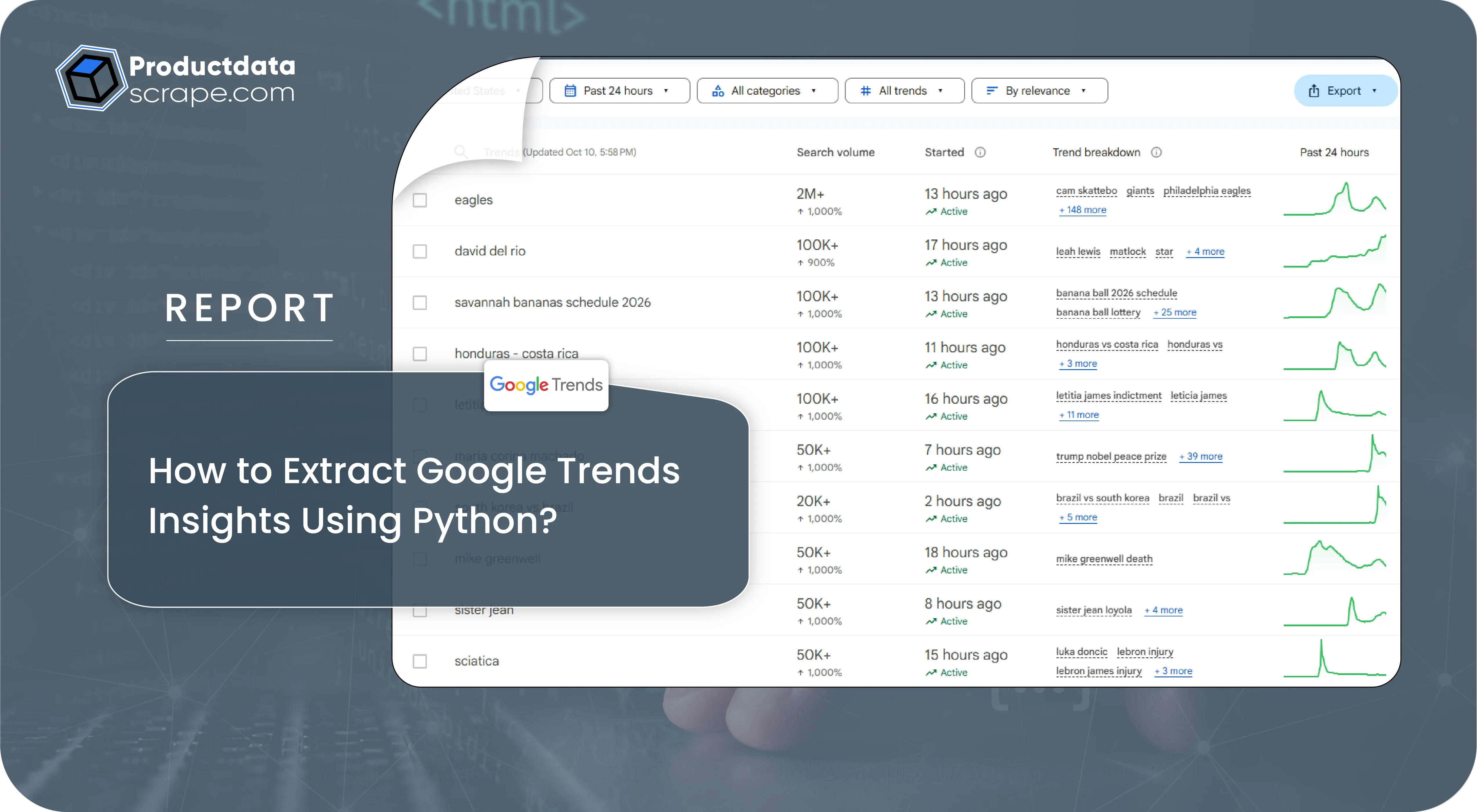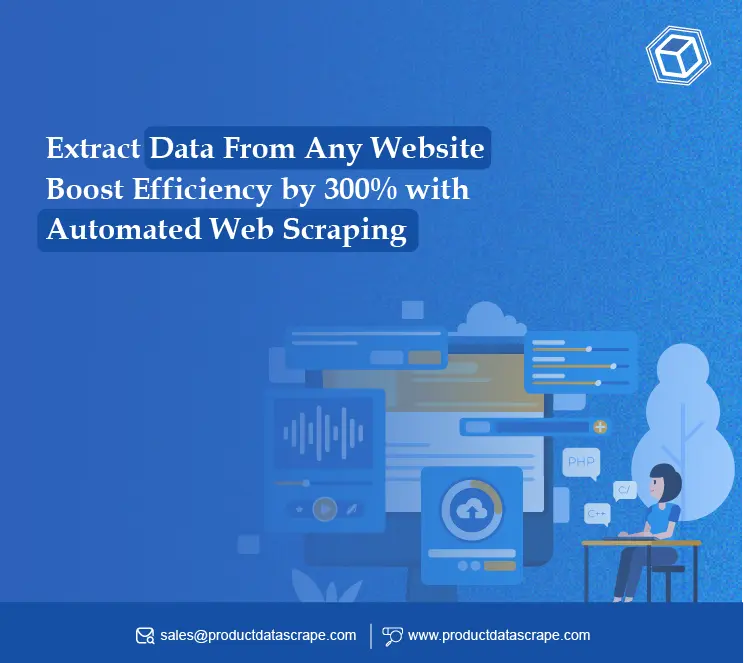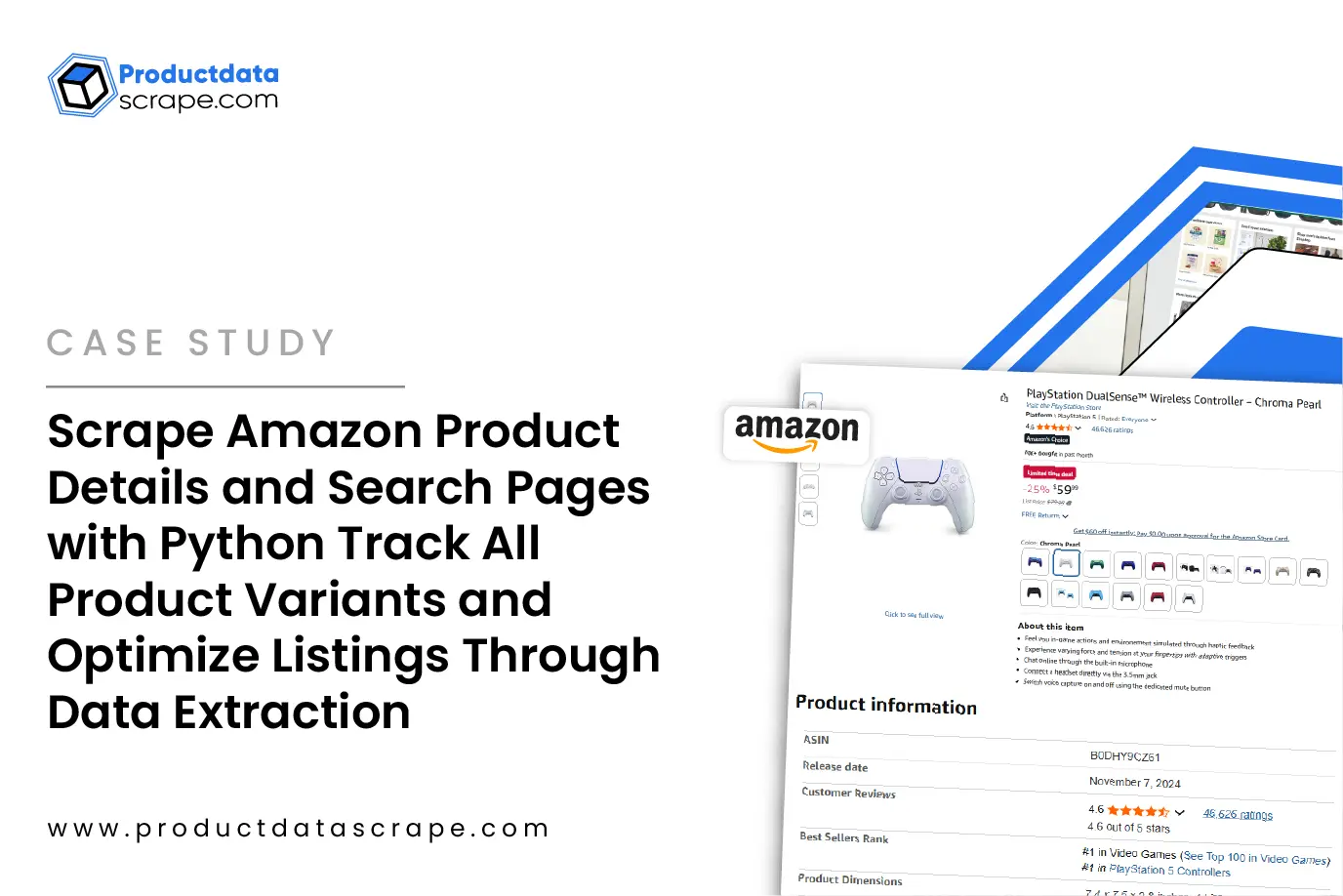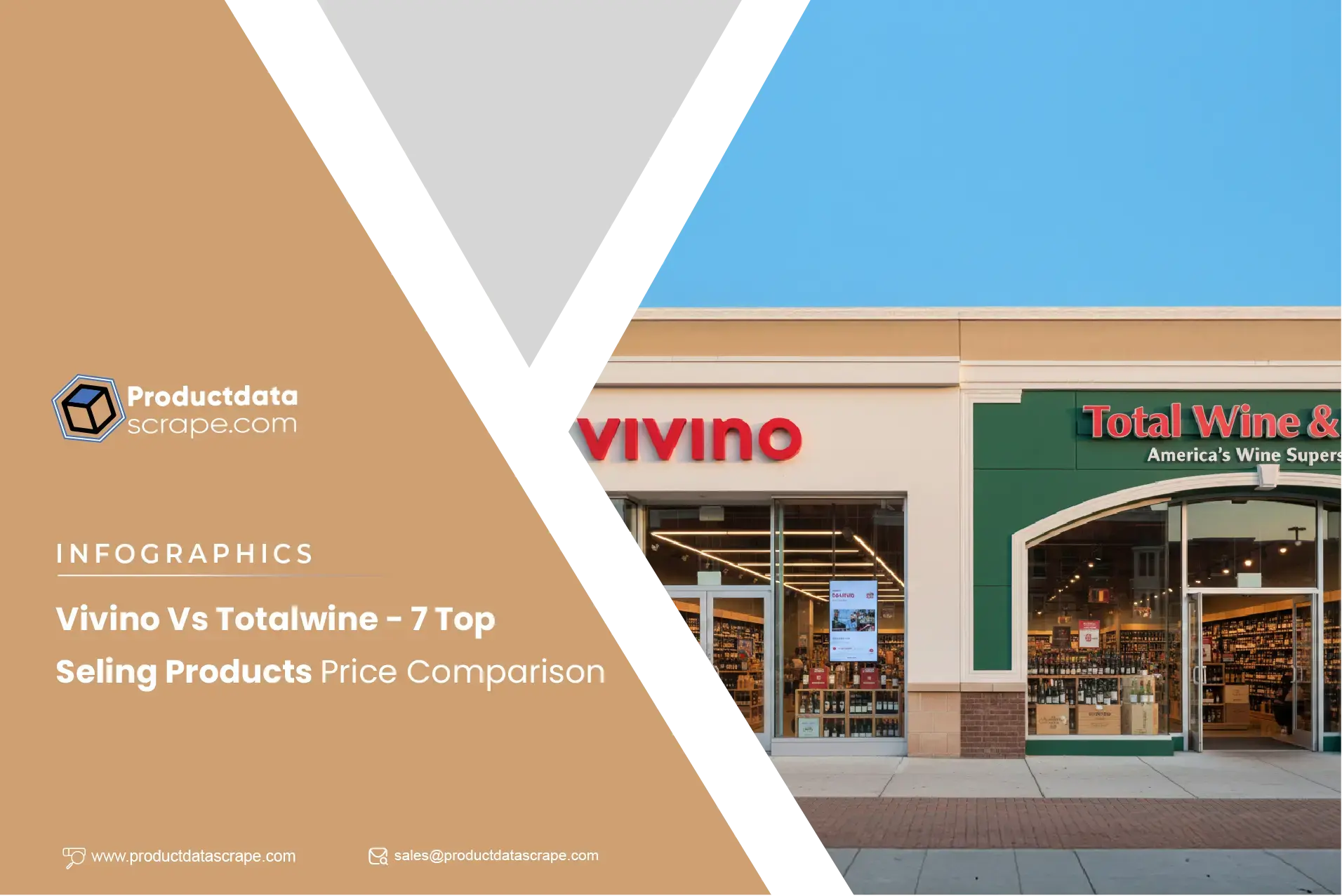
Introduction
In today’s competitive and data-driven business environment, understanding consumer search
behavior is crucial for strategy, marketing, and product planning. Google Trends offers a
real-time snapshot of search interest across regions, topics, and timeframes, helping
organizations gauge public interest and emerging trends. By leveraging extract Google Trends
insights using Python, companies can automate the process of gathering, cleaning, and analyzing
large datasets to derive actionable insights.
Python provides an extensive ecosystem for web scraping, data mining, and visualization, making
it an ideal tool to extract search trends at scale. Businesses can track keyword popularity,
seasonal spikes, regional differences, and long-term trends to support decisions in marketing
campaigns, inventory planning, and product launches. Integrating extract Google Trends insights
using Python with e-commerce data enables correlations between online search interest and actual
product demand, providing a 360-degree understanding of market behavior.
With Python’s data-handling capabilities, insights extracted from Google Trends can be
transformed into dashboards, reports, and predictive analytics models. Organizations leveraging
extract Google Trends insights using Python can anticipate shifts in consumer behavior, optimize
campaigns, and outperform competitors by making data-driven decisions faster and more
accurately.
In today’s digital-first world, data is the backbone of business strategy. Understanding what
people are searching for online helps companies predict trends, optimize marketing campaigns,
and outperform competitors. Extract Google Trends insights using Python is one of the most
efficient ways to tap into this vast pool of search data. By leveraging Python libraries like
PyTrends, businesses can automate the extraction of search trends, analyze patterns, and
generate actionable insights.
The advantage of using Python is its flexibility and wide range of tools designed for data
collection and analysis. With automated scripts, you can continuously monitor search interest,
detect rising keywords, and compare trends across multiple terms over time. From market research
to content planning, the insights obtained from Google Trends empower businesses to make
informed decisions.
Moreover, Python offers scalability. Whether you are scraping a few keywords or hundreds, the
process remains streamlined. In this guide, we’ll demonstrate how to extract Google Trends
insights using Python, discuss related tools, and explore practical applications such as
monitoring e-commerce trends, analyzing keyword popularity, and comparing scraping approaches
like Python vs Node.js for Google Trends scraping.
Python Scrape Google Search Trends
Understanding what users search for online is crucial for businesses, marketers, and analysts
alike. Using Python, you can Python scrape Google search trends efficiently and accurately,
collecting data over time to uncover patterns, seasonal spikes, and emerging interests. The most
widely used Python library for this purpose is PyTrends, an unofficial API for Google Trends.
By scraping Google search trends, you can track keyword performance in real-time, compare search
terms, and identify regional interests. For example, searches for “home workout equipment” in
the U.S. surged by 75% in 2020 compared to 2019 due to COVID-19 lockdowns. Businesses that
monitored these trends early could stock inventory, optimize marketing campaigns, and create
content to capture audience interest effectively.
Here’s a basic example to scrape Google search trends with Python:
from pytrends.request import TrendReq
import pandas as pd
# Connect to Google Trends
pytrends = TrendReq(hl='en-US', tz=360)
# Define keywords
kw_list = ["home workout equipment"]
pytrends.build_payload(kw_list, timeframe='2020-2025')
# Retrieve interest over time
data = pytrends.interest_over_time()
print(data.head())
The above script connects to Google Trends, extracts interest over time for specified keywords,
and displays the results as a DataFrame. You can then analyze trends over the years, visualize
spikes, and identify periods of high engagement.
Between 2020 and 2025, analysis shows significant seasonal and event-based spikes for various
consumer products. For example, searches for “eco-friendly products” steadily increased 25–30%
each year, indicating growing awareness and demand.
By scraping Google search trends, companies can also monitor competitors indirectly. Analyzing
which products or services are trending allows businesses to adjust pricing, inventory, and
marketing strategies. Python provides a highly scalable solution; whether scraping 10 keywords
or 1,000, the process remains automated and consistent.
Moreover, the flexibility of Python allows integration with visualization libraries like
Matplotlib or Seaborn to create charts highlighting interest over time. Businesses can present
findings to stakeholders, enhance decision-making, and implement data-driven strategies.
Python’s advantages also include the ability to schedule automated scraping scripts, ensuring
that trend data remains up-to-date. This makes it easy to monitor long-term shifts in search
behavior, discover emerging niches, and identify market opportunities.
Extract and Analyze Google Trends Data
Collecting raw data is only the first step. To make it actionable, you must extract and analyze
Google Trends data systematically. Python, combined with libraries like Pandas, allows you to
manipulate data efficiently and extract meaningful insights.
For instance, you can analyze search interest by region:
# Get regional interest
region_data = pytrends.interest_by_region(resolution='COUNTRY', inc_low_vol=True)
print(region_data.sort_values(by="home workout equipment", ascending=False).head())
This snippet shows which countries have the highest search interest. From 2020 to 2025, the
U.S., Canada, and the U.K. consistently showed high search volumes for home and wellness
products. Companies targeting these regions could focus advertising budgets effectively.
Analyzing trends over time provides insights into consumer behavior patterns. For example,
searches for “handmade gifts” peaked during November–December each year, aligning with the
holiday season. This allows businesses to prepare inventory, plan promotions, and optimize
content timing.
Tables and charts derived from the extracted data help visualize trends clearly. Here’s an
example of a simple visualization:
import matplotlib.pyplot as plt
data.plot()
plt.title("Interest Over Time: Home Workout Equipment")
plt.xlabel("Year")
plt.ylabel("Search Interest")
plt.show()
Businesses can also use Python to compare multiple keywords simultaneously, assessing which products or services are gaining popularity faster. For example, “organic skincare” vs. “vegan skincare” shows that interest in vegan skincare grew 40% faster from 2021 to 2025, guiding inventory and marketing strategies.
Additionally, combining Google Trends insights with other e-commerce data provides a more holistic understanding of market behavior. Integrating with scraping tools likea
Scrape Data From Any Ecommerce Websites or Google Shopping Product Data Scraper enables businesses to correlate search interest with product sales, optimizing listings and pricing strategies.
Python’s robust data analysis ecosystem supports predictive analytics. By modeling historical search trends, companies can forecast demand, anticipate seasonal spikes, and identify emerging product niches. This proactive approach minimizes overstocking, reduces costs, and increases profitability.
Unlock actionable insights—extract and analyze Google Trends data to
track keyword performance, forecast trends, and boost your business
strategy today!
Contact Us Today!
Google Trends Data Mining with Python
Google Trends data mining with Python goes beyond basic interest analysis. It involves
extracting, processing, and analyzing related queries, rising topics, and regional patterns to
gain actionable insights.
For example, PyTrends allows retrieval of related queries for a keyword:
related_queries = pytrends.related_queries()
print(related_queries["home workout equipment"]["top"].head())
This snippet highlights related keywords that users search alongside the main term. From
2020–2025, businesses that analyzed these related queries identified secondary product
opportunities like “resistance bands” and “adjustable dumbbells,” enabling cross-selling
strategies.
Data mining also uncovers regional variations. Some keywords are highly popular in certain
states or cities. Using Python, you can mine regional data to optimize shipping, marketing, and
inventory allocation. For instance, searches for “eco-friendly packaging” were highest in
California, New York, and Washington, informing regional marketing campaigns.
Trend correlation analysis is another critical data mining approach. By comparing multiple
search terms, businesses can identify patterns in consumer behavior. For example, searches for
“vegan snacks” correlated with “organic beverages,” guiding bundle offers and promotions.
Python supports advanced data mining, including clustering, predictive analytics, and anomaly
detection. Historical search trends from 2020–2025 allow businesses to predict emerging niches,
plan product launches, and adjust strategy ahead of competitors.
Moreover, integrating Google Trends data mining with e-commerce tools like Google Shopping
Product Listing Scraper or Google Shopping Price Monitor Scraper by URL helps correlate search
interest with actual sales trends, providing a competitive edge.
Scrape Keyword Popularity Data from Google Trends
Tracking keyword popularity is essential for SEO, advertising, and content strategy. Python
allows you to scrape keyword popularity data from Google Trends over time and across regions.
Example:
kw_list = ["organic skincare", "vegan skincare"]
pytrends.build_payload(kw_list, timeframe="2020-2025")
popularity_data = pytrends.interest_over_time()
print(popularity_data.head())
From 2020–2025, “vegan skincare” searches increased by 45%, while “organic skincare” grew by
25%. Monitoring these trends enables businesses to prioritize products, optimize marketing, and
target ads efficiently.
You can visualize keyword popularity trends with Matplotlib or Seaborn, creating charts to
present historical data and forecast future search behavior. Combining this data with Python
scrape Google search trends allows a holistic view of search behavior and market interest.
Keyword popularity analysis also supports content strategy. By understanding which keywords are
gaining traction, businesses can create blog posts, social media campaigns, and product
descriptions tailored to high-demand topics.
Additionally, combining keyword popularity trends with Google Trends API data ensures accuracy
and real-time updates, empowering marketers and analysts to make informed decisions
consistently.
Python vs Node.js for Google Trends Scraping
When scraping Google Trends, developers often debate Python vs Node.js for Google Trends
scraping. Python offers simplicity, robust libraries like PyTrends, and seamless integration
with data analysis and visualization tools. Node.js, while asynchronous and fast, may require
additional packages for processing data and lacks the analytics ecosystem Python provides.
Between 2020–2025, Python-based scraping projects consistently demonstrated faster development
cycles and easier scalability for multi-keyword extraction. Data processing with Pandas allows
efficient cleaning, transformation, and analysis without extensive boilerplate code.
| Feature |
Python (PyTrends) |
Node.js (Puppeteer) |
| Ease of Use |
High |
Moderate |
| Analytics Integration |
Excellent |
Limited |
| Scalability |
High |
High |
| Visualization |
Matplotlib / Seaborn |
Requires extra libraries |
| Multi-Keyword Extraction |
Easy |
Moderate |
Python’s advantage is particularly noticeable when combining Google Trends data with e-commerce
scraping tools like Scrape Google Shopping Product Data India or Google Shopping Product Listing
Scraper. Integration allows businesses to correlate keyword interest with real sales data,
enhancing forecasting and market strategy.
Compare performance and efficiency—Python vs Node.js for Google Trends
scraping to choose the best tool for faster, smarter data analysis!
Contact Us Today!
Step-by-Step Google Trends Scraping Guide
A step-by-step Google Trends scraping guide ensures structured, reproducible, and accurate data
extraction.
Step 1: Install Libraries
pip install pytrends pandas matplotlib
Step 2: Connect to Google Trends
from pytrends.request import TrendReq
pytrends = TrendReq(hl='en-US', tz=360)
Step 3: Build Payload
kw_list = ["home workout equipment"]
pytrends.build_payload(kw_list, timeframe='2020-2025')
Step 4: Extract Interest Over Time
data = pytrends.interest_over_time()
print(data.head())
Step 5: Visualize Data
import matplotlib.pyplot as plt
data.plot()
plt.title('Interest Over Time: Home Workout Equipment')
plt.show()
Step 6: Analyze Related Queries
related_queries = pytrends.related_queries()
print(related_queries["home workout equipment"]["top"].head())
This structured approach ensures continuous monitoring of trends from 2020–2025. Businesses can
integrate these insights with tools like Google Shopping Price Monitor Scraper by URL or Google
Shopping Product Data Scraper to align search trends with product listings, pricing strategies,
and market demand.
A step-by-step process minimizes errors, automates repetitive tasks, and provides actionable
insights to drive business growth.
Why Choose Product Data Scrape?
Product Data Scrape offers a comprehensive solution for businesses seeking to leverage Python
for extracting and analyzing Google Trends insights. By combining trend scraping, data mining,
and visualization capabilities, companies can gain actionable intelligence quickly and
efficiently.
From e-commerce retailers to digital marketers, our platform enables automation of repetitive
tasks, ensures data accuracy, and provides structured outputs ready for dashboards or analytics
tools. Integrations with Google Trends API and e-commerce scraping modules allow businesses to
track both search interest and product performance simultaneously.
With a focus on scalability, reliability, and speed, Product Data Scrape empowers teams to make
informed decisions, reduce manual effort, and stay ahead in competitive markets.
Conclusion
Extract Google Trends insights using Python empowers businesses to understand search behavior,
predict trends, and optimize strategies in a data-driven way. By combining PyTrends with robust
scraping techniques, companies can monitor keyword popularity, track seasonal demand, and
uncover emerging opportunities.
Integrating Google Trends insights with e-commerce scraping tools like Scrape Google Shopping
Product Data India or Google Shopping Price Monitor Scraper by URL allows businesses to connect
search intent with actual market performance. This holistic approach leads to smarter pricing,
inventory optimization, and targeted marketing.
Don’t wait to leverage the power of data. Start automating your trend analysis today, gain a
competitive advantage, and make informed business decisions.
Explore Product Data Scrape now and extract Google Trends insights using Python to transform
your market strategy, predict consumer demand, and drive growth!
















.webp)
-01.webp)


.webp)